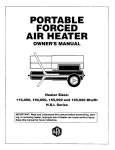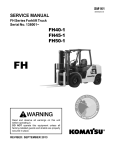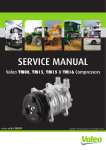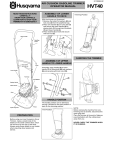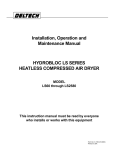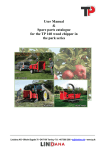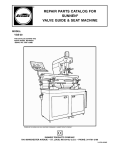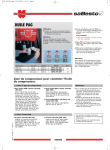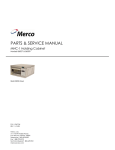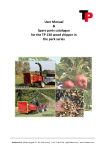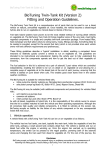Download Technical Note 6001A TTY Air conditioning
Transcript
Technical Note 6001A TTY Air conditioning All types General procedures Edition 3 77 11 327 562 AUGUST 2004 "The repair methods given by the manufacturer in this document are based on the technical specifications current when it was prepared. The methods may be modified as a result of changes introduced by the manufacturer in the production of the various component units and accessories from which his vehicles are constructed." Edition Anglaise All copyrights reserved by Renault. The reproduction or translation in part of whole of the present document, as well as the use of the spare parts reference numbering system, are prohibited without the prior written consent of Renault. © Renault s.a.s. 2005 Air conditioning Air conditioning ContentsPage Contents Page 62A AIR CONDITIONING General information 62A-1 Air conditioning: Precautions for repair 62A-6 Consumables 62A-7 Air conditioning: Function of components 62A-13 Air conditioning: Check 62A-21 Fault finding 62A-22 Coolant circuit check 62A-24 Coolant circuit Draining Refilling 62A-27 Evaporator: Cleaning 62A-30 AIR CONDITIONING General information Some vehicles now have a climate control system combining the heating system (production of warm air) with the air conditioning system (production of cold air), to cope with the discomfort caused by weather conditions (heat waves, cold snaps, etc.). The climate control system controls the passenger compartment's internal temperature as well as on the humidity level of the air to increase comfort for the occupants. In some situations (prolonged parking in direct sunlight), the temperature can become difficult to bear or even present a genuine hazard. To obtain an acceptable comfort level quickly, evacuate the overheated air by leaving the doors open for a few minutes, then start the vehicle and activate the climate control; it can also be used to demist the windows more quickly in cold weather by drying the air. IMPORTANT Never exceed a temperature difference between the exterior and interior of more than 20˚C, as this could cause the occupants to catch cold. Note: - Keep the windows closed when using the air conditioning to improve efficiency of the latter, - Use air recirculation to supplement the air conditioning in very hot weather: however, only use air recirculation for a maximum of 10 minutes since this function, though sometimes limited automatically, isolates the passenger compartment from the exterior by reusing the internal air, which thins the oxygen inhaled and increases the humidity level, - Use the air conditioning regularly throughout the year to keep it in good condition. 62A-1 62A AIR CONDITIONING General information 62A 18 7 20 15 13 9 19 6 5 16 13 12 8 1 4 10 14 11 2 3 17 91096 (1) Compressor (2) Condenser (3) Dehydration canister (4) Pressure sensor (5) High pressure valve 62A-2 (6) Expansion valve (7) Evaporator (8) Low pressure valve (9) Air conditioning blower (10) Engine cooling fan (11) Cooling radiator AIR CONDITIONING General information (12) High pressure fluid (13) Low pressure vapour (14) High pressure vapour (15) Passenger compartment (16) Engine compartment (17) External air (18) Towards air mixing unit (19) Scuttle panel bulkhead (20) External or recirculated air 62A-3 62A AIR CONDITIONING General information 62A 16 6 11 13 18 7 11 17 11 14 11 11 1 3 11 8 12 9 2 5 4 10 15 102327 (1) Compressor (2) Condenser (3) Dehydration canister (4) Pressure sensor (5) Calibrated choke 62A-4 (6) Evaporator (7) Air conditioning blower (8) Engine cooling fan (9) Cooling radiator (10) High pressure fluid (11) Low pressure vapour AIR CONDITIONING General information (12) High pressure vapour (13) Passenger compartment (14) Engine compartment (15) External air (16) To mixing unit (17) Scuttle panel bulkhead (18) External or recirculated air the system, the climate control computer manages air distribution and ventilation to achieve the desired comfort level. Note: For more information on the system, refer to all the documentation for the vehicle. REMINDER 5 3 2 1 4 6 91814 (1) Compressor (2) Expansion valve (3) Condenser (4) Evaporator (5) High pressure (6) Low pressure 62A Assemblies (1), (2), (3), (4) and the connecting piping are known as the cold loop. There are two types of comfort level regulation: - manual systems, - automatic systems. Manual systems are regulated directly by the user, who selects a comfort level and adjusts the settings to obtain this level. Automatic systems are managed by the air conditioning computer, which analyses various data (internal temperature, external temperature, etc.). In addition to 62A-5 AIR CONDITIONING Air conditioning: Precautions for repair IMPORTANT 62A IMPORTANT - Repairing any faulty components of the air conditioning system is strictly prohibited. The following must be worn when handling refrigerant fluid: - Any faulty component must be replaced. • gloves, Pipes must be correctly routed. • protective eyewear (with side shields where possible). Ensure that the refrigerant piping is correctly attached to prevent contact with metal parts in the engine compartment. - In the event of refrigerant fluid coming into contact with the eyes, rinse thoroughly with plain water for 15 minutes. - Keep eyewash available if possible. - If refrigerant comes into contact with your eyes, consult a doctor immediately. Inform the doctor that the burns were caused by R134A refrigerant. - In the event of contact with other unprotected parts of the body (despite the safety advice being followed), rinse well with clean water continuously for 15 minutes. IMPORTANT - Any work involving refrigerants must be carried out in a well ventilated area. - The refrigerant must not be stored in a well, a pit, a hermetically sealed room, etc. - Refrigerants are colourless and odourless fluids. Refrigerants are denser than air and so they sink to the ground. This results in a risk of asphyxiation. Consequently, when working on the system ensure that there are no pits, wells, ventilation shafts, etc., any nearer than 5 m away, and run the gas extraction equipment. At above 100˚C, due to a hot spot for example, refrigerant decomposes and produces a highly irritant gas. IMPORTANT It is prohibited to carry out welding or brazing on: - components of the air conditioning system when these are in place, - the vehicle, if there is a risk of overheating an air conditioning component. It is possible to place components in the drying oven after painting or to carry out work near the system if the temperature does not exceed 80˚C. 62A-6 AIR CONDITIONING Consumables 62A TWINGO Engine (specification) Compressor Type of oil Total volume of oil in the circuit (ml or C3G SANDEN SD7H15 D7F SD7V16 cm3) 650 ± 35 PAG SP 10 135 ± 10 740 ± 35 PAG SP 10 D7F/D4F Refrigerant capacity (g) 700 ± 35 SD6V12 CLIO II Engine (specification) Compressor All engines SD6V12 K4M/K4J (Mexico) SD7V16 Type of oil Refrigerant capacity (g) 660 ± 35 PAG SP 10 K4M/K4J (manufactured in Turkey with automatic transmission) Total volume of oil in the circuit (ml or cm3) SD7V16 830 ± 35 135 ± 10 740 ± 35 CLIO III Engine (specification) Compressor Type of oil Total volume of oil in the circuit (ml or cm3) Refrigerant capacity (g) D4F K4M K4J Sanden SD6V12 PAG SP 10 135 ± 10 530 ± 35 Compressor Type of oil Total volume of oil in the circuit (ml or cm3) Refrigerant capacity (g) Sanden SD6V16 PAG SP 10 135 ± 10 530 ± 35 K9K MODUS Engine (specification) D4F K4M K4J K9K 62A-7 AIR CONDITIONING Consumables 62A LOGAN Engine (specification) Compressor Type of oil Total volume of oil in the circuit (ml or K7M Sanden SD7V16 SD7V12 K7J K9 or SANDEN SD7V16 cm3) Refrigerant capacity (g) PAG SP 10 135 ± 10 840 ± 35 PAG SP 10 135 ± 10 840 ± 35 MEGANE Engine (specification) Compressor Type of oil Total volume of oil in the circuit (ml or cm3) Refrigerant capacity (g) E7J/K7M DELPHI V5 PLANETELF PAG 488 220 ± 15 750 ± 35 K7M MERCO SD6V12 PAG SP 10 135 ± 10 750 ± 35 K4J/K4M DELPHI 6CVC135 PLANETELF PAG 488 and 897 150 ± 10 700 ± 35 F3R MERCO SANDEM SD7V16 PAG SP 10 135 ± 10 780 ± 35 F4P/F4R/F5R DELPHI V5 PLANETELF PAG 488 220 ± 15 750 ± 35 F8Q/F9Q DELPHI V5 PLANETELF PAG 488 220 ± 15 750 ± 35 SCENIC Engine (specification) Compressor Type of oil Total volume of oil in the circuit (ml or cm 3) Refrigerant capacity (g) K4M/K4J (left-hand drive) 680 ± 35 K4M/K4J drive) 780 ± 35 ( right-hand 680 ± 35 F4 (left-hand drive) F4 (right-hand drive) DELPHI V5 PLANETELF PAG488 220 ± 15 780 ± 35 F4 (Mexico) 750 ± 35 F9Q (left-hand drive) 680 ± 35 F9Q (right-hand drive) 780 ± 35 62A-8 AIR CONDITIONING Consumables 62A MEGANE II Engine (specification) Compressor Type of oil Total volume of oil in the circuit (ml or cm 3) Refrigerant capacity (g) K4J/K4M/F4/F5/K9K/F9Q DELPHI 6CVC135 PLANETELF PAG 488 150 ± 10 550 ± 35 M9R DELPHI 5CVC126 PLANETELF PAG 488 150 ± 10 650 ± 35 Engine (specification) Compressor Type of oil Total volume of oil in the circuit (ml or cm 3) Refrigerant capacity (g) K4J/K4M/F4/F5/K9K/F9Q DELPHI 6CVC135 PLANETELF PAG 488 150 ± 10 550 ± 35 M9R DELPHI 5CVC126 PLANETELF PAG 488 150 ± 10 650 ± 35 SCENIC II LAGUNA Engine (specification) Compressor Type of oil Total volume of oil in the circuit (ml or K4M/N7Q/F4P/F3R/F3P/ F9Q/G8T (turbocharger)/ F4R cm 3) Refrigerant capacity (g) 700 ± 35 SANDEN SD7H15 PAG SP 10 135 ± 15 780 ± 35 F3P (LPG)/Z7X/L7X/G8T (Normally aspirated) LAGUNA II Engine (specification) Compressor Type of oil Total volume of oil in the circuit (ml or cm 3) K4/F4P/F4R/F5R/F9Q/ G9T DELPHI V5 PLANETELF PAG488 265 ± 15 L7X SANDEN SD7V16 PAG SP 10 135 †15 M9R ZEXEL-VALEO ZXL100PG 210 ± 10 62A-9 Refrigerant capacity (g) 650 ± 35 AIR CONDITIONING Consumables 62A VELSATIS Engine (specification) Compressor Type of oil Total volume of oil in the circuit (ml or cm 3) G9T/F4RT DELPHI V5 PLANETELF PAG488 220 ± 15 V4Y CALSONIC V6 PAG SP 10 220 ± 15 P9X DENSO 7SBU16 ND-OIL8 245 ± 15 Engine (specification) Compressor Type of oil Total volume of oil in the circuit (ml or cm3) F4/G9T/F9Q DELPHI 7CVCE PLANETELF PAG 488 200 ± 10 V4Y CALSONIC V6 PLANETELF PAG 488 220 ± 15 Refrigerant capacity (g) 650 ± 35 ESPACE IV Refrigerant capacity (g) 1000 ± 35 P9X DENSO 7SBU16 ND-OIL8 245 ± 15 M9R ZEXEL KC88 ZXL 100 PG 210 ± 10 Compressor Type of oil Total volume of oil in ESPACE III Engine (specification) the circuit (ml or cm 3) Refrigerant capacity (g) F3R/Z7X/G9T 820 ± 30 L7X 890 ± 30 F4R SANDEN SD7H15 PAG SP 10 135 ± 15 750 ± 30 G8T 700 ± 35 F9Q 720 ± 35 AVANTIME Engine (specification) Compressor Type of oil Total volume of oil in the circuit (ml or cm3) L7X SANDEN SD7V16 PAG SP 10 135 ± 15 F4R/G9T DELPHI V5 PLANETELF PAG 488 220 ± 15 62A-10 Refrigerant capacity (g) 800 ± 35 AIR CONDITIONING Consumables 62A SAFRANE Engine (specification) Compressor Type of oil Total volume of oil in the circuit (ml or cm3) Refrigerant capacity (g) SANDEN SD7H15 PAG SP 10 135 ± 15 810 ± 35 Engine (specification) Compressor Type of oil Total volume of oil in the circuit (ml or cm3) Refrigerant capacity (g) All engines SD6V12 K4M/K4J (Mexico) SD7V16 All engines KANGOO K4M/K4J (manufactured in Turkey with automatic transmission) 660 ± 35 830 ± 35 PAG SP 10 135 ± 10 Type of oil Total volume of oil in SD7V16 740 ± 35 TRAFIC Engine (specification) Compressor the circuit (ml or cm3) 750 ± 35 All engines (van) All engines (with additional air conditioning) Refrigerant capacity (g) DELPHI V5 PLANETELF PAG 488 220 ± 15 Compressor Type of oil Total volume of oil in the circuit (ml or cm 3) 1050 ± 35 MASTER Engine (specification) 850 ± 35 S8U/S9W (van) S8U/S9W MPV) (9-seater S8U/S9W MPV) (16-seater SANDEN SD6V12 PAG SP 10 135 ± 15 1400 ± 35 1200 ± 35 850 ± 35 F9Q/G9T/G9U (van) F9Q/G9T/G9U (9-seater MPV) Refrigerant capacity (g) DELPHI V5 PLANETELF PAG 488 220 ± 15 1400 ± 35 1200 ± 35 F9Q/G9T/G9U (16-seater MPV) 62A-11 AIR CONDITIONING Consumables 62A Table of volumes of oil to add when replacing components: Operation on the air conditioning circuit Volume of oil (ml or cm 3) Circuit oil change Measure the volume recovered and add the same volume of new oil Split hose or other rapid leak 100 Replacement of a condenser Volume recovered +30 Replacement of an evaporator Volume recovered +30 Replacement of the dehydration canister Volume recovered + 15 Replacing a hose Volume recovered + 10 Removing/refitting the compressor Quantity recovered Replacing a compressor None added replacing a compressor in standard exchange top up as necessary Replacing a compressor and one or several climate control circuit component(s). None added Replacing a compressor in standard exchange and one or several air conditioning circuit component(s) top up as necessary 62A-12 AIR CONDITIONING Air conditioning: Function of components 62A I - COMPRESSOR The compressor places the gas from the evaporator under high pressure. To do this, it is driven in rotation by the engine using a belt and an electromagnetic clutch. IMPORTANT Since the compressor is a rotating unit, it must be run with oil of the correct grade and volume (see Air conditioning, Consumables). When the compressor is replaced, it is supplied with the correct level of oil, except in standard exchanges. Top up the oil for compressors in standard exchanges. Whenever a job requires the compressor to be removed, always replace all belts removed and tighten them to the specified tension if there are no automatic tensioners. II - CONDENSER 102328 There are two types of compressor in the RENAULT range: - fixed capacity compressors, - variable capacity compressors. Fixed capacity compressors have an oscillating plate driven by a shaft: this is used to intake the refrigerant at low pressure and discharge it at high pressure by actuating the pistons cycle. Variable capacity compressors operate on the same principle, except that the oscillating plate can also vary the stroke of the pistons according to two types of device: - pneumatic: the gradient value depends on the low pressure, - electronic: the gradient is controlled by a signal from the evaporator sensor and the high pressure. 20968 The condenser is installed after the compressor in the circuit; it is located in front of the engine radiator and is intended to dissipate the heat accumulated during compression of the gas. Once cooled, the gas becomes liquid and remains under high pressure. WARNING Take care not to damage the condenser and radiator fins while handling them. Check that the condenser is well-maintained and that the seals on the piping are in good condition. 62A-13 AIR CONDITIONING Air conditioning: Function of components 62A Dehydration canister (2) or the "reservoir" is located between the condenser and the expansion valve. In this type of set-up, the refrigerant fluid circulates in the dehydration canister in liquid form. III - EVAPORATOR 108097 Evaporator (1) cools and dries the passenger compartment inlet air. The refrigerant absorbs heat, the humidity in the air is condensed and evacuated outside via a drain pipe (water under vehicle when stationary). IV - DEHYDRATION CANISTER The dehydration canister acts as a reservoir, filter and humidity absorber. 102021 Dehydration canister (3) or the "accumulator" is placed at the evaporator outlet to protect the compressor from any liquid coming in at the intake point. Whatever the type of dehydration canister, reservoir or accumulator, it must always be replaced if the circuit has been opened to the air and the circuit has not been plugged as indicated. The dehydration canister cannot be repaired. V - EXPANSION VALVE The expansion valve is used to convert the fluid from a high pressure liquid state to a low pressure liquid + gas state. Even though there are two types of expansion valve, the system operation is the same. WARNING The expansion valve cannot be repaired. 104963 62A-14 AIR CONDITIONING Air conditioning: Function of components 62A The expansion valves with calibrated openings are positioned at the condenser outlet. These expansion valves are built into the pipe: the pressure reduction is achieved through a restriction in the tube. Since the fluid travels through the expansion valves in one direction only, unlike the thermostatic expansion valves, there is less room taken up in the engine compartment. VI - PIPING The piping assembly is composed of pipes (flexible rubber piping which is reinforced to make it more watertight) and tubes (rigid aluminium piping). This piping allows the fluid to circulate in various forms around the circuit. 91819 The thermostatic expansion valves are located beyond the dehydration canister. This type of expansion valve operates according to the temperature of the fluid at the evaporator outlet and proceeds in a cycle as follows: - if the temperature is high, the refrigerant contained in the tube and the capsule expands and increases the fluid inlet, causing a greater pressure reduction and thereby a drop in temperature; - if the temperature drops, the volume of the tube and capsule contents decreases and the needle closes the fluid inlet valve. 19330 62A-15 AIR CONDITIONING Air conditioning: Function of components 62A 110142 62A-16 AIR CONDITIONING Air conditioning: Function of components 62A VII - SEALS These isolate the air conditioning circuit from the outside. They are O-ring or Euro Manuli seals and are found on each circuit connection. WARNING To avoid any leaks, check that the pipe surface is sound before positioning the new seal. The surface must be clean and scratch free. VIII - FILLER VALVE A filler valve is used to fill the circuit with refrigerant or drain it. Most systems have two (one for high pressure, one for low pressure), but on vehicles equipped with orificetype expansion valves there is only one valve. 104112 For vehicles that only use one valve (4), this will be a large diameter valve, which is placed on the low pressure circuit WARNING Comply with the recommended valve tightening torques: - Small diameter: 8 Nm - Large diameter: 10 Nm. 96838 On circuits equipped with two valves, the valves have different diameters to avoid any interchange. Large diameter valve for the high pressure circuit. Small diameter valve for the low pressure circuit. 62A-17 AIR CONDITIONING Air conditioning: Function of components 62A Any work on these components can be carried out without draining the refrigerant fluid circuit: they are mounted on a non-return valve. IX - TRI-FUNCTION PRESSOSTAT WARNING These components are fitted with a seal: make sure that it is in good condition and lubricate it with the air conditioning oil recommended for the system (see TN 6001A, Air conditioning, Consumables). XI - PASSENGER COMPARTMENT FAN ASSEMBLY CONTROL UNIT 82822 The tri-function pressostat is used to control the air conditioning compressor and the engine cooling fans. The pressostat is fitted on the high pressure section of the circuit and ensures the following functions: Low pressure cut-out (approximately 2 bar): - If the high pressure in the circuit reaches too low a value (below a given threshold), then the tri-function pressostat cuts the supply to the compressor clutch (e.g. refrigerant fluid load too low, could lead to the compressor seizing up through lack of lubricant and refrigerant fluid). High pressure cut-out (approximately 27 bar): - When the pressure of the circuit is too high (above a given threshold) and represents a danger to the circuit, the tri-function pressostat cuts the supply to the compressor clutch. 102235 This varies the fan assembly speed using a resistance system. Ventilation fans control (approximately 19 bar): - If the pressure rises, the tri-function pressostat selects the ventilation fan(s) at either mid-speed or full speed depending on the circumstances. This promotes heat exchange and improves condensation to limit the pressure. X - PRESSURE SENSOR This has the same function as the tri-function pressostat, i.e. measuring the pressure in the high pressure circuit. It sends the signal back to the air conditioning or engine management computer, which manages the system accordingly. 62A-18 AIR CONDITIONING Air conditioning: Function of components 62A XII - POWER MODULE Note: This sensor is not always used; see Workshop Repair Manual for the vehicle concerned. 102237 17929 This varies the fan assembly speed using an electronic system. Although the procedure for removal is the same (rotate through a quarter turn), their accessibility in the passenger compartment varies according to the vehicle. Note: XV - EXTERNAL TEMPERATURE SENSOR In general, the modules can be accessed without removing the fan unit or any other system. This sensor supplies information about the outside temperature. XIII - FLAP CONTROL MOTORS These motors are located in the distribution unit and actuate the flaps to direct the flow according to certain criteria: It is located either in the right-hand door mirror or in the passenger compartment air inlet. It is a negative temperature coefficient thermistor. - The mixing motor is used to mix warm air and cold air to obtain the required comfort level, - the distribution motor directs the air flow into the passenger compartment via the vents, - the recirculation motor can re-use the air in the passenger compartment by isolating the compartment from the external air, - the demisting motor directs the air flow to the windscreen via the vents. XIV - EVAPORATOR SENSOR This sensor measures the air temperature at the evaporator; there are different models but the operating principle is the same. This sensor is a negative temperature coefficient thermistor. With the signal provided by this sensor, the computer can react accordingly to protect the evaporator from freezing by cutting off the compressor. 62A-19 110308 AIR CONDITIONING Air conditioning: Function of components XVI - PASSENGER COMPARTMENT TEMPERATURE SENSOR This sensor supplies information on the interior temperature. It is a negative coefficient thermistor. 19398 XVII - HUMIDITY DETECTER This capacitance sensor measures, through the increase in resistance, the humidity of the air in the vehicle interior to determine whether or not air recirculation should be actuated. XVIII - SOLAR RADIATION DETECTER This sensor informs the computer of the intensity of sunlight to correct the air flow to the air vents. XIX - TOXICITY SENSOR This sensor continuously analyses the change in concentration of gases (CO and NOx) in the passenger compartment to isolate the compartment, if necessary, by actuating the air recirculation system. 62A-20 62A AIR CONDITIONING Air conditioning: Check 62A Ambient temperature Acceptable temperature at the centre air vents outlet 15˚C between 4˚C and 8˚C 20˚C between 6˚C and 10˚C 25˚C between 8˚C and 13˚C 30˚C between 12˚C and 16˚C 35˚C between 17˚C and 20˚C 40˚C between 21˚C and 25˚C PRELIMINARY CHECK Activate the air conditioning. Check the temperature of the air blown from the centre air vents using a thermometer, 6 minutes after the air conditioning is switched on and refer to the table above. The temperature must not change more than ± 0.5˚C. Check the battery voltage (see 80A, Battery, Battery: Test). Check that the particle filter is clean (if easily accessible). Note: ADVICE FOR IDENTIFYING THE SYSTEM Check for foreign bodies in the passenger compartment filter housing, and clean thoroughly if necessary. Use the diagnostic tool to identify the system fitted in the vehicle (reading the group, program number, etc.). CHECKING THAT THE AIR CONDITIONING IS EFFICIENT I - PREPARING THE VEHICLE Keep the vehicle in the shade for approximately an hour (doors, windows and bonnet closed, centre air vent open). II - METHOD OF USE Start the vehicle's engine (leave it idling). Make sure that the air conditioning is not activated. Wait 2 minutes. Adjust the air conditioning controls: - temperature: maximum cold setting, - distribution: centre air vent (all at face level), - ventilation: maximum setting, - recirculation: open (external air position). Check the temperature of the air blown from the centre air vents using a thermometer: - the temperature must be the same as the ambient air temperature ± 5˚C. 62A-21 Find the Fault finding documents corresponding to the system identified. AIR CONDITIONING Fault finding Before proceeding with any fault finding on the air conditioning, follow these preliminary steps: The fault detection table below refers to all air conditioning systems (automatic or otherwise). This table is only shown as an example as not all of the components listed are used (see MR of vehicle concerned). 62A The following figures indicate the most common causes of faults (repeated where there is more than one cause at the same time). Causes Components No cold air Too much cold air Inefficient operation Fuses 1 - - Air distribution 1 1 - Air flow 1 - 1 Recirculation flap - - 1 Passenger compartment blower - - 1 Lack of refrigerant 1 - 2 Compressor belt (condition or tension) 2 - 2 Wiring harness assembly 3 - 2 Evaporator sensor 4 2 3 Sensor signal 4 2 3 Pressure sensor 4 3 4 Cooling fan - - 4 Compressor clutch relay 5 - - Compressor clutch 5 - - Compressor 5 - 5 Expansion valve 5 - 5 Dehydration canister - - 5 Control panel 6 4 6 Fault finding table for lack of cold air Possible cause Check Remedy Belt slipping Belt tension Tighten belt Compressor not working 1- Check the load Readjust the load 2- Check the power supply Repair 3- Check the pressostat Replace the pressostat 62A-22 AIR CONDITIONING Fault finding 62A Possible cause Check Remedy Expansion valve Check the temperature difference between the inlet and outlet Replace the expansion valve if there is no difference Calibrated opening Check the temperature difference between the inlet and outlet Replace the calibrated opening if there is no difference Condenser Check the exterior cleanliness Clean the exterior of the condenser Evaporator Check the exterior cleanliness Clean the exterior of the evaporator Check that the evaporator is not frozen Check the evaporator sensor 1- Check the cleanliness of the condenser Clean the exterior of the condenser 2- Excess load Readjust the load 3- Insufficient cooling Check that the ventilation fans are working properly 1- Excess load Readjust the load 2- Check the expansion valve Replace the expansion valve High pressure circuit too high Low pressure circuit too high 62A-23 AIR CONDITIONING Coolant circuit check 62A Fault finding for detecting leaks: Component Detection area Part to be replaced after first check Part to be replaced after filling and second check Condenser Inlet or outlet Pipes Condenser Evaporator Connection flange Pipes Connection flange and/or evaporator Compressor Inlet or outlet Pipes Compressor Dehydration canister Inlet or outlet Pipes Dehydration canister There are several types of devices for detecting leaks: II - TRACE DETECTORS Detecting leaks using a trace involves adding a dye to the refrigerant, and locating the points of loss using an ultraviolet light. - electronic detectors, - trace detectors. Note: IMPORTANT Use the electronic detector and then the trace detector to check for leaks. Be sure to observe the safety instructions when working on the cold loop (see 62A, Air conditioning, Safety instructions). I - ELECTRONIC DETECTORS WARNING The procedure described must be observed. WARNING Always consult the user manual for the device before carrying out any work. Note: This device measures variation in the quantity of refrigerant in the air: it emits an audible signal depending on this variation. The device must be initialised before checking. To do this: - immobilise the device, - calibrate the device in the engine compartment, - do not start the engine. This point is then used as standard for detecting the contamination rate. This equipment is highly sensitive: during the detection process, follow the line of the circuit only as closely as possible in order to limit variations caused by other gases. This device only detects relatively substantial leaks. WARNING Make sure that the sensor at the end of the rod is kept extremely clean and in good condition. 62A-24 Use this leak protection procedure as a last resor t for « leaks that cannot be found ». AIR CONDITIONING Coolant circuit check 62A 1 - Injecting dye into the circuit 2 1 3 105944 105944 The refrigerant leak detection procedure is based on the use of a dye available as a single-use capsule (1): fluid traces are revealed using an ultraviolet light (2). Set up the dye injection system on the low pressure valve, observing the product's direction of circulation, using union (3), for vehicles with a single valve. The dye remains in the air conditioning system. Inject the dye into the circuit. The condition of the cold loop can be checked using an ultraviolet light without introducing fresh dye. Run the air conditioning system for approximately 15 minutes. If there is nothing to indicate that dye has been used previously (label, etc.): - have a cloth ready, - release a small jet of refrigerant through the two valves, - shine the ultraviolet light inside the valves, - check for fluorescent traces. WARNING Adding dye to the cold loop is prohibited if fluorescent traces appear. Add a dose of detection dye if there are no fluorescent traces or label. Affix a label. Record the date when the dye was added. 62A-25 AIR CONDITIONING Coolant circuit check 2 - Leak detection procedure Note: After any wor k on air conditioning circuit leaks on the Laguna II, Vel Satis and Espace IV, fault Refrigerant DF033 must always be cleared using the diagnostic tool. The compressor cannot operate until the fault is cleared. Carry out an initial check (with the engine stopped) by sweeping the circuit with an ultraviolet light. Note: Use an adjustable mirror wherever access is difficult. If no leak is apparent: - carefully clean the exterior of the coolant circuit, - run the air conditioning system until the leak can be detected (if no leak is detected, check the condition of the evaporator). WARNING After injecting dye into the refrigerant, be sure to indicate this on a label (supplied with the dye capsule), and the date of the operation. The label should be positioned so that it is visible close to the cold loop filler valve (shock absorber cup). 62A-26 62A AIR CONDITIONING Coolant circuit Draining - Refilling 62A When replacing a compressor and one or more of the various air conditioning circuit components, the quantity of oil in the compressor is sufficient to lubricate the entire circuit. Do not add oil. Equipment required filling station WARNING I - FLUID Lubricants are not mutually compatible: always adhere to the types and grades of oil required for each compressor, even when topping up, or you could break the cold loop. Previously, the refrigerant used was R12 refrigerant (seeNT 2494A, R12/R134a Conversion and NT 2422A, R12/R134a Conversion). It has been withdrawn from use and replaced with refrigerant fluid R134A, which is less hazardous. Always close oil cans after use to prevent moisture getting inside, and never use oil contained in a can that has been open for a long time (viscous appearance). Note: All vehicles using R134A have a label in the engine compartment specifying its use. III - PROCUREMENT OF OIL PAG SP10: Part no. 77 01 419 313 PLANETELF PAG 488: Part no. 77 11 172 668 To find out the type of oil used (see 62A, Air conditioning, Consumables). 96811 Refrigerant R134A is colourless in its liquid state, and odourless and invisible in its gaseous state. A summary table provides the quantities of refrigerant for the system for the various vehicles (see TN 6001A, Air conditioning, Consumables). II - OIL The cold loop contains a special oil to lubricate the compressor. Fill up with the same quantity of oil as was drained. When replacing a component, top up the oil with the volume required for the component replaced (see NT 6001A, Air conditioning, Consumables). 62A-27 AIR CONDITIONING Coolant circuit Draining - Refilling IV - RECOVERING REFRIGERANT FLUID 62A - switch off the engine, - drain for the first time (note down the value), Note: - wait 15 minutes, - The air conditioning circuit is fitted with a single filler valve; some stations only require the high pressure pipe to be used (see the filling station instructions). - run the engine until the cooling fan is triggered twice, - drain for the second time (note down the value), - Depending on the situation, run the system for a few minutes before recovering the coolant to improve drainage. - start the drain cycles again if the relative pressure is above 0 bar, - add together the values of the various draining operations; the fill is confirmed as being correct if the volume of refrigerant fluid is the specified fill + 35 g or - 100 g. IMPORTANT These procedures must be followed in order to prevent: - gas escaping when the circuit is opened, Scenario C: - environmental damage through the release of gas into the atmosphere when the circuit is opened or when a vacuum is created. - drain for the first time (note down the value), - wait 2 hours, - start the drain cycles again if the relative pressure is above 0 bar, When draining or checking the refrigerant fluid fill load, three situations must be taken into account: - add together the values of the various draining operations; the fill is confirmed as being correct if the volume of refrigerant fluid is the specified fill + 35 g or - 100 g. - the engine and air conditioning are working (scenario A), - the engine is working but not the air conditioning (scenario B), - neither the engine nor the air conditioning are working (scenario C). V - CREATION OF A VACUUM Scenario A: - run the air conditioning until the cooling fan has been triggered twice, Evacuation needs to be carried out properly before the filling procedure, otherwise the air conditioning will not operate properly. - switch off the engine, There are two scenarios to consider: - drain for the first time (note down the original value), - the vacuum will be created immediately after draining (scenario A), - wait 15 minutes, - check that the relative pressure is no more than 0 bar, - start the drain cycles again if the relative pressure is above 0 bar, - add together the values of the various draining operations; the fill is confirmed as being correct if the volume of refrigerant fluid is the specified fill + 35 g or - 100 g. - the vacuum will be created after a delay of several hours or days (scenario B). Scenario A: - creating a vacuum takes 20 minutes. Scenario B: Scenario B: - creating a vacuum takes 45 minutes to remove any residual moisture. - run the engine until the cooling fan is triggered twice, Test the tightness once evacuation is complete (some stations do this automatically). 62A-28 AIR CONDITIONING Coolant circuit Draining - Refilling VI - FILLING Note: After any wor k on air conditioning circuit leaks on the Laguna II, Vel Satis and Espace IV, filling fault Refrigerant DF033 must always be cleared using the diagnostic tool. The compressor cannot operate until the fault is cleared. Top up the oil with the recommended type and volume of oil, depending on the work carried out. Fill up Air conditioning, Consumables). Empty the pipes on the filling station. Check that the system is working correctly (seeAir conditioning, Air conditioning: Test). Check for leaks. 62A-29 62A AIR CONDITIONING Evaporator: Cleaning Air conditioning cleaner: Part no. 77 01 410 170 II - CLIO III I - TWINGO, LAGUNA, SAFRANE, CLIO I, MEGANE I 1 - Left-hand drive Position the vehicle on a lift. 62A a - REMOVAL 16458 Run an extension piece through the condensation drain pipe to apply the air conditioning cleaner. 112763 Unclip the passenger compartment filter. Spray the entire contents of the can. Leave the product to work for 15 minutes. Note: Run the fan assembly very slowly for 5 minutes. Foreign bodies (leaves, insects etc.) are likely to accumulate in the passenger compartment filter. Remove the filter with care so as to prevent foreign bodies getting into the evaporator. WARNING Do not spray the cleaner via the air inlet, as this could damage the fan assembly. Remove the passenger compartment filter. Check for foreign bodies in the passenger compartment filter housing, and clean thoroughly if necessary. Apply the air conditioning cleaner using an extension piece. The end of the extension piece must be positioned at the base of the evaporator. Spray the entire contents of the can. Leave the product to work for 15 minutes. Run the fan assembly very slowly for 5 minutes. WARNING Do not spray the cleaner via the air inlet, as this could damage the fan assembly. 62A-30 AIR CONDITIONING Evaporator: Cleaning 62A b - REFITTING b - REFITTING Refit the passenger compartment filter. Refit the passenger compartment filter. III - MEGANE II 2 - Right-hand drive 1 - Left-hand drive a - REMOVAL a - REMOVAL 112850 Unclip the passenger compartment filter. 101295 Remove the trim at (1). Note: Foreign bodies (leaves, insects etc.) are likely to accumulate in the passenger compartment filter. Remove the filter with care so as to prevent foreign bodies getting into the evaporator. Remove the passenger compartment filter. Check for foreign bodies in the passenger compartment filter housing, and clean thoroughly if necessary. Apply the air conditioning cleaner using an extension piece. The end of the extension piece must be positioned at the base of the evaporator. Spray the entire contents of the can. Leave the product to work for 15 minutes. Run the fan assembly very slowly for 5 minutes. WARNING Do not spray the cleaner via the air inlet, as this could damage the fan assembly. 62A-31 AIR CONDITIONING Evaporator: Cleaning 104113 Move the refrigerant pipe (2) to one side of the distribution unit. Turn the refrigerant pipe through a quarter turn. Remove the refrigerant pipe at the distribution unit end. Apply the air conditioning cleaner using an extension piece. The end of the extension piece must be positioned at the base of the evaporator. Spray the entire contents of the can. Leave the product to work for 15 minutes. Run the fan assembly very slowly for 5 minutes. WARNING Do not spray the cleaner via the air inlet, as this could damage the fan assembly. b - REFITTING Refit the refrigerant pipe at the distribution unit end. Refit the trim under the glovebox. 62A-32 62A AIR CONDITIONING Evaporator: Cleaning 62A 2 - Right-hand drive WARNING Do not spray the cleaner via the air inlet, as this could damage the fan assembly. a - REMOVAL b - REFITTING Refit the passenger compartment filter. Refit the trim under the glovebox. Note: - Break the rigid sections of the filter to make it easier to refit. - Be sure not to damage the filtering section. IV - LAGUNA II 1 - Left-hand drive a - REMOVAL 102238 Remove the trim at (3). Note: Foreign bodies (leaves, insects etc.) are likely to accumulate in the passenger compartment filter. Remove the filter with care so as to prevent foreign bodies getting into the evaporator. Check for foreign bodies in the passenger compartment filter housing, and clean thoroughly if necessary. Remove passenger compartment filter (4). Note: Break the rigid sections of the filter in order to remove it. 19187 Remove: Apply the air conditioning cleaner using an extension piece. The end of the extension piece must be positioned at the base of the evaporator. Spray the entire contents of the can. Leave the product to work for 15 minutes. Run the fan assembly very slowly for 5 minutes. 62A-33 - the right-hand traim from the centre console (5), - the soundproofing below the storage compartment (6). AIR CONDITIONING Evaporator: Cleaning 62A 112012 19336 Disconnect the connector (7) from the fan assembly. Remove fan assembly mounting bolt (9). Move the refrigerant pipe (8). Turn the fan assembly through a quarter turn. Apply the air conditioning cleaner using an extension piece. The end of the extension piece must be positioned at the base of the evaporator. Remove the fan assembly. Apply the air conditioning cleaner using an extension piece. Spray the entire contents of the can. Spray the entire contents of the can. Leave the product to work for 15 minutes. Leave the product to work for 15 minutes. Run the fan assembly very slowly for 5 minutes. Run the fan assembly very slowly for 5 minutes. WARNING Do not spray the cleaner via the air inlet, as this could damage the fan assembly. WARNING Do not spray the cleaner via the air inlet, as this could damage the fan assembly. b - REFITTING b - REFITTING Refit the refrigerant pipe. Refit the fan assembly. Connect the fan assembly connector. Refit the fan assembly mounting bolt. Refit the soundproofing below the storage compartment. Refit the soundproofing below the storage compartment. Refit the right-hand trim to the centre console, V - SCENIC II 2 - Right-hand drive Left-hand and Right-hand drive a - REMOVAL Remove the soundproofing below the storage compartment. a - REMOVAL 62A-34 Remove the engine covers. AIR CONDITIONING Evaporator: Cleaning 62A Refit the passenger compartment filter access flap, Note: - Break the rigid sections of the filter to make it easier to refit. - Be sure not to damage the filtering section. 106340 Remove: - the passenger compartment filter access flap (10), Note: Break the rigid sections of the filter in order to remove it. Note: Foreign bodies (leaves, insects etc.) are likely to accumulate in the passenger compartment filter. Remove the filter with care so as to prevent foreign bodies getting into the evaporator. Remove the passenger compartment filter. Check for foreign bodies in the passenger compartment filter housing, and clean thoroughly if necessary. Apply the air conditioning cleaner using an extension piece. The end of the extension piece must be positioned at the base of the evaporator. Spray the entire contents of the can. Leave the product to work for 15 minutes. Run the fan assembly very slowly for 5 minutes. WARNING Do not spray the cleaner via the air inlet, as this could damage the fan assembly. b - REFITTING Refit the passenger compartment filter. 62A-35 AIR CONDITIONING Evaporator: Cleaning 62A Leave the product to work for 15 minutes. VI - CLIO II Run the fan assembly very slowly for 5 minutes. WARNING a - REMOVAL Do not spray the cleaner via the air inlet, as this could damage the fan assembly. b - REFITTING Refit the passenger compartment filter. Refit the passenger compartment filter cover. Refit the fan assembly guard bolt. Refit the scuttle panel grille. Refit the wiper arms. 105792 Remove: - the wiper arms, - the scuttle panel grille (see MR 338 Bodywork, 55D, Exterior protection, Scuttle panel grille ), - the fan assembly guard mounting bolts, - the passenger compartment filter cover mounting bolts (11). - the passenger compartment filter. Note: Foreign bodies (leaves, insects etc.) are likely to accumulate in the passenger compartment filter. Remove the passenger compartment filter with care so as to prevent foreign bodies getting into the evaporator. Remove the passenger compartment filter. Check for foreign bodies in the passenger compartment filter housing, and clean thoroughly if necessary. Apply the air conditioning cleaner using an extension piece. The end of the extension piece must be positioned at the base of the evaporator. Spray the entire contents of the can. 62A-36 AIR CONDITIONING Evaporator: Cleaning 62A Leave the product to work for 15 minutes. VII - KANGOO Run the fan assembly very slowly for 5 minutes. WARNING a - REMOVAL Do not spray the cleaner via the air inlet, as this could damage the fan assembly. b - REFITTING Refit the passenger compartment filter. Refit the passenger compartment filter cover. Refit the fan assembly guard bolt. Refit the scuttle panel grille. Refit the wiper arms. VIII - ESPACE IV Position the vehicle on a lift. 105792 Remove: - the wiper arms, - the scuttle panel grille (see MR 381 Bodywork, 56A, Exterior accessories, Scuttle panel grille: Removal - Refitting). - the fan assembly guard mounting bolts, - the passenger compartment filter cover mounting bolts (12). - the passenger compartment filter. Note: Foreign bodies (leaves, insects etc.) are likely to accumulate in the passenger compartment filter. Remove the passenger compartment filter with care so as to prevent foreign bodies getting into the evaporator. 103220 Run an extension piece through the condensation drain pipe (13) to apply the air conditioning cleaner. Remove the passenger compartment filter. Spray the entire contents of the can. Check for foreign bodies in the passenger compartment filter housing, and clean thoroughly if necessary. Leave the product to work for 15 minutes. Apply the air conditioning cleaner using an extension piece. The end of the extension piece must be positioned at the base of the evaporator. Spray the entire contents of the can. 62A-37 Run the fan assembly very slowly for 5 minutes. WARNING Do not spray the cleaner via the air inlet, as this could damage the fan assembly. AIR CONDITIONING Evaporator: Cleaning IX - MODUS 62A b - REFITTING Tilt the passenger compartment filter before inserting it into the air conditioning unit. 1 - Left-hand drive Engage the upper section of the base of the filter into the air conditioning unit. a - REMOVAL 109614 Raise passenger compartment filter tab (14). Rotate the filter around the upper section of the base of the filter. Release the upper section of the base of the filter from the air conditioning unit. Note: Foreign bodies (leaves, insects etc.) are likely to accumulate in the passenger compartment filter. Remove the passenger compartment filter with care so as to prevent foreign bodies getting into the evaporator. Remove the passenger compartment filter. Check for foreign bodies in the passenger compartment filter housing, and clean thoroughly if necessary. Apply the air conditioning cleaner using an extension piece. The end of the extension piece must be positioned at the base of the evaporator. Spray the entire contents of the can. Leave the product to work for 15 minutes. Run the fan assembly very slowly for 5 minutes. WARNING Do not spray the cleaner via the air inlet, as this could damage the fan assembly. 62A-38 AIR CONDITIONING Evaporator: Cleaning 2 - Right-hand drive 62A b - REFITTING Tilt the passenger compartment filter before inserting it into the air conditioning unit. a - REMOVAL Engage the upper section of the base of the filter into the air conditioning unit. X - MASTER 109862 Raise passenger compartment filter tab (15). Rotate the filter around the upper section of the base of the filter. Release the upper section of the base of the filter from the air conditioning unit. 104964 Apply the cleaner using an extension piece via the condensation drain pipe (located on the engine compartment side bulkhead). Note: Foreign bodies (leaves, insects etc.) are likely to accumulate in the passenger compartment filter. Remove the passenger compartment filter with care so as to prevent foreign bodies getting into the evaporator. Note: Bend the end piece so that when it is inserted into the condensation drain pipe it is forced to the left-hand side of the technician. Remove the passenger compartment filter. Spray the entire contents of the can. Check for foreign bodies in the passenger compartment filter housing, and clean thoroughly if necessary. Leave the product to work for 15 minutes. Apply the air conditioning cleaner using an extension piece. The end of the extension piece must be positioned at the base of the evaporator. Spray the entire contents of the can. Leave the product to work for 15 minutes. Run the fan assembly very slowly for 5 minutes. WARNING Do not spray the cleaner via the air inlet, as this could damage the fan assembly. 62A-39 Run the fan assembly very slowly for 5 minutes. WARNING Do not spray the cleaner via the air inlet, as this could damage the fan assembly. AIR CONDITIONING Evaporator: Cleaning XI - TRAFIC XII - VELSATIS a - REMOVAL a - REMOVAL 20566 62A 19187 Remove the trim at (16). Remove: Remove the refrigerant pipe at the distribution unit end. - the right-hand trim from the centre console (17), Apply the air conditioning cleaner using an extension piece. The end of the extension piece must be positioned at the base of the evaporator. Spray the entire contents of the can. Leave the product to work for 15 minutes. Run the fan assembly very slowly for 5 minutes. WARNING Do not spray the cleaner via the air inlet, as this could damage the fan assembly. b - REFITTING Refit the refrigerant pipe at the distribution unit end. Refit the trim under the glovebox. 62A-40 - the soundproofing below the storage compartment (18). AIR CONDITIONING Evaporator: Cleaning 112012 Move refrigerant pipe (19). Apply the air conditioning cleaner using an extension piece. The end of the extension piece must be positioned at the base of the evaporator. Spray the entire contents of the can. Leave the product to work for 15 minutes. Run the fan assembly very slowly for 5 minutes. WARNING Do not spray the cleaner via the air inlet, as this could damage the fan assembly. b - REFITTING Refit the refrigerant pipe. Refit the soundproofing below the storage compartment. Refit the right-hand trim to the centre console, 62A-41 62A












































